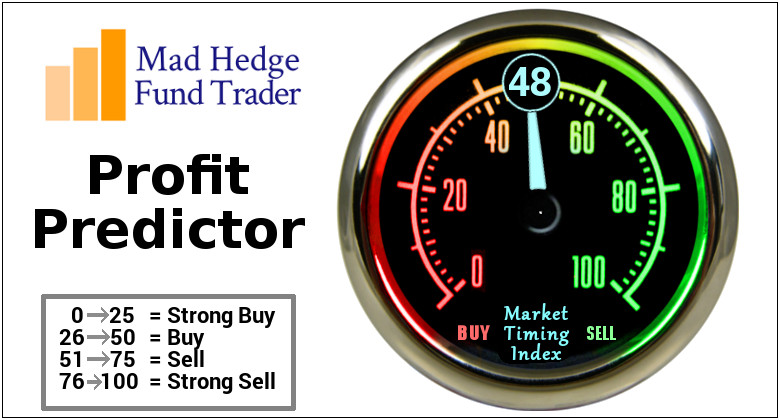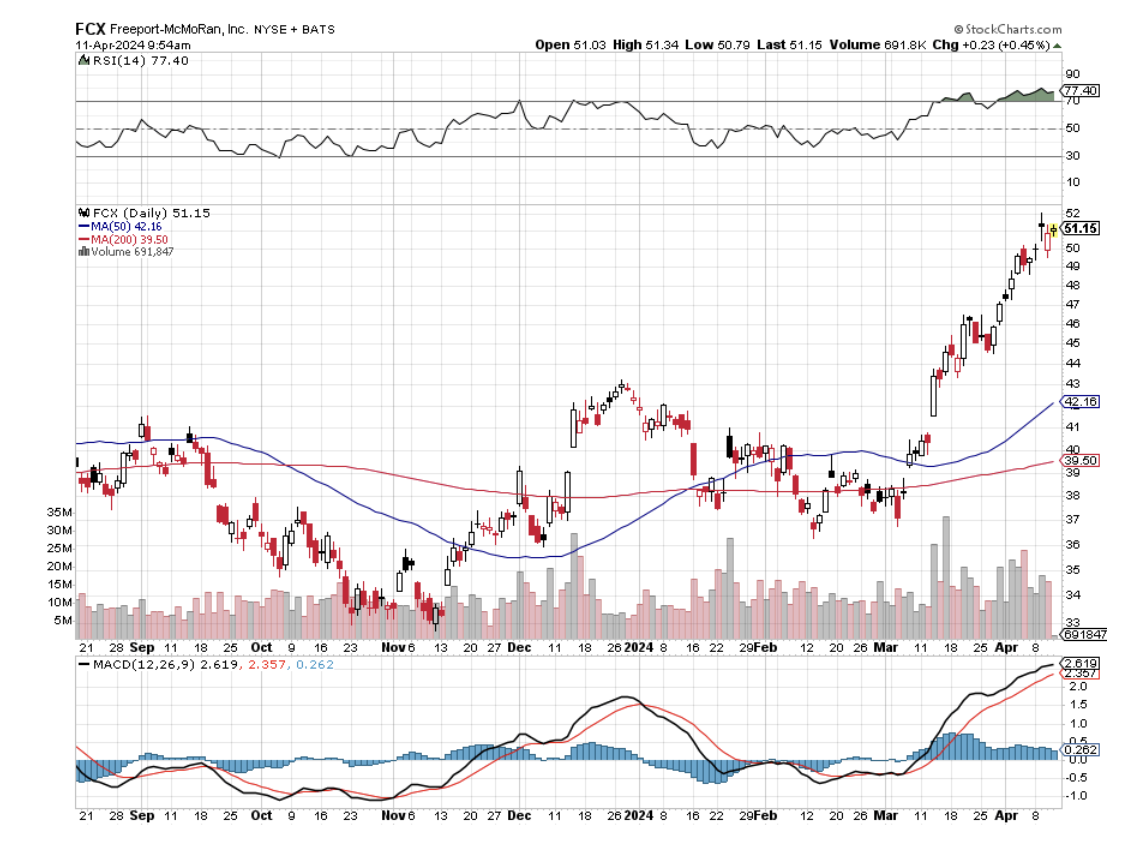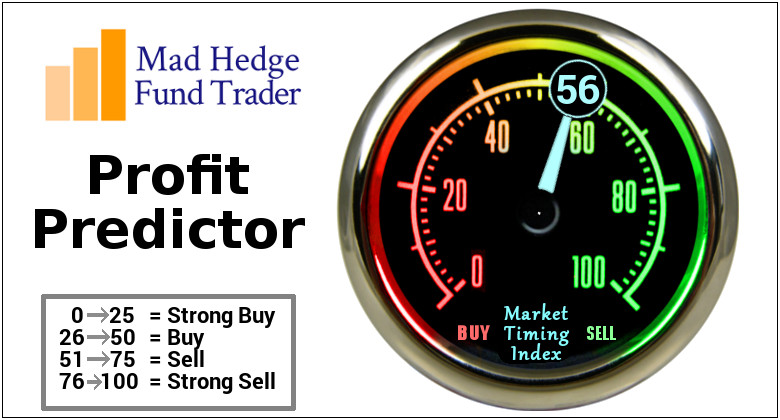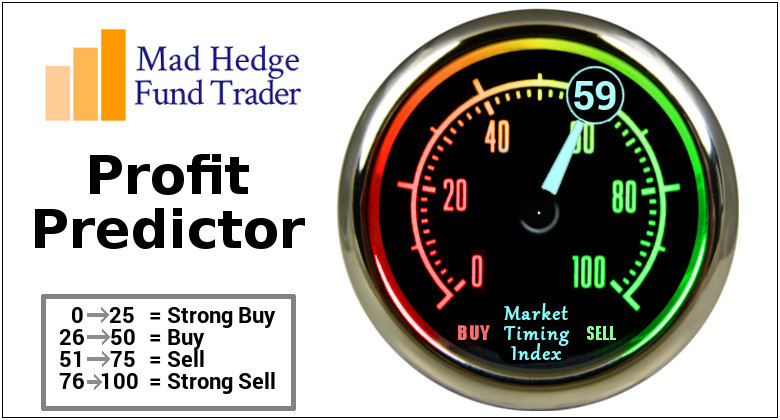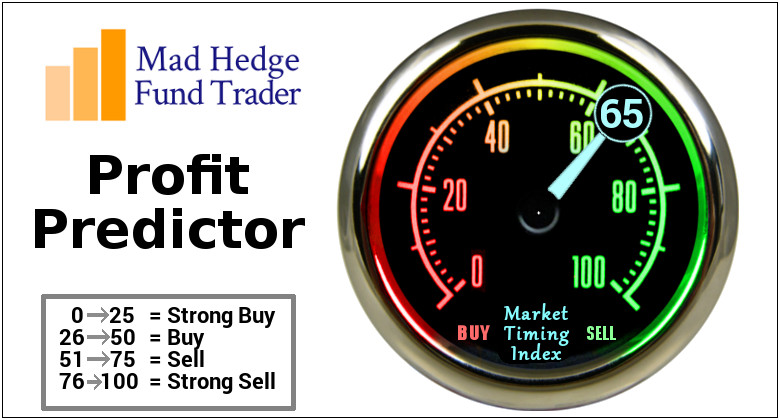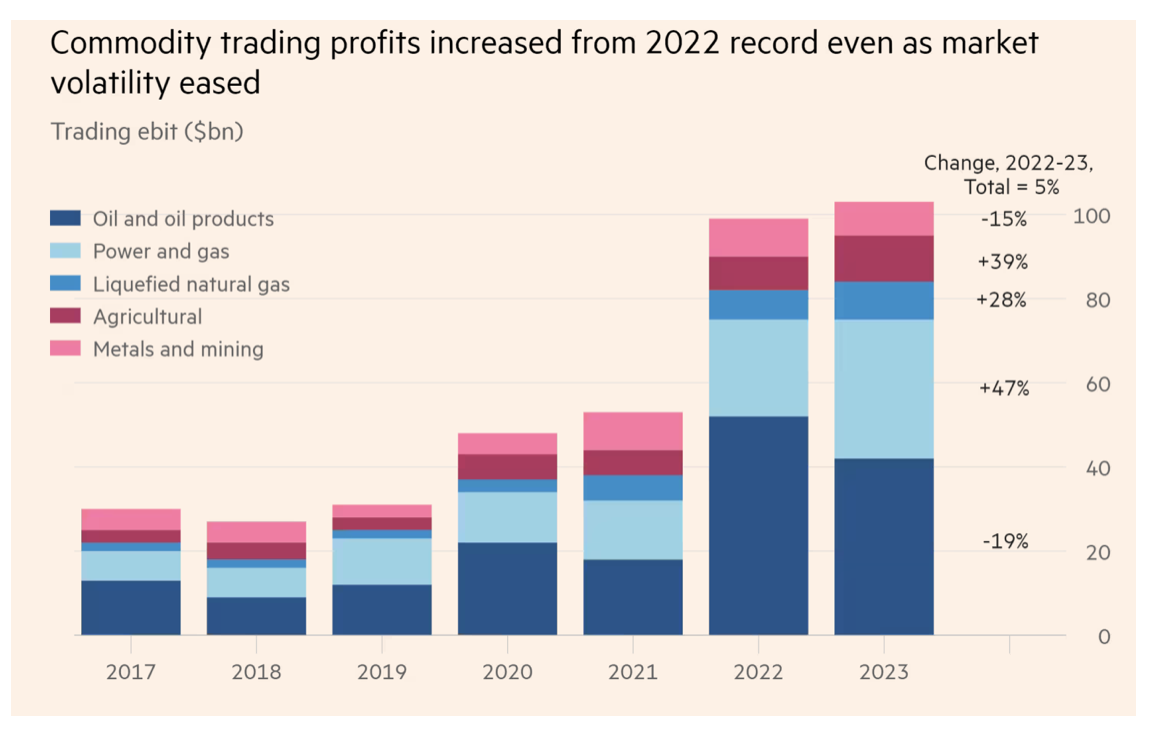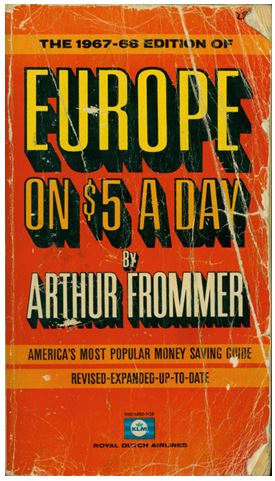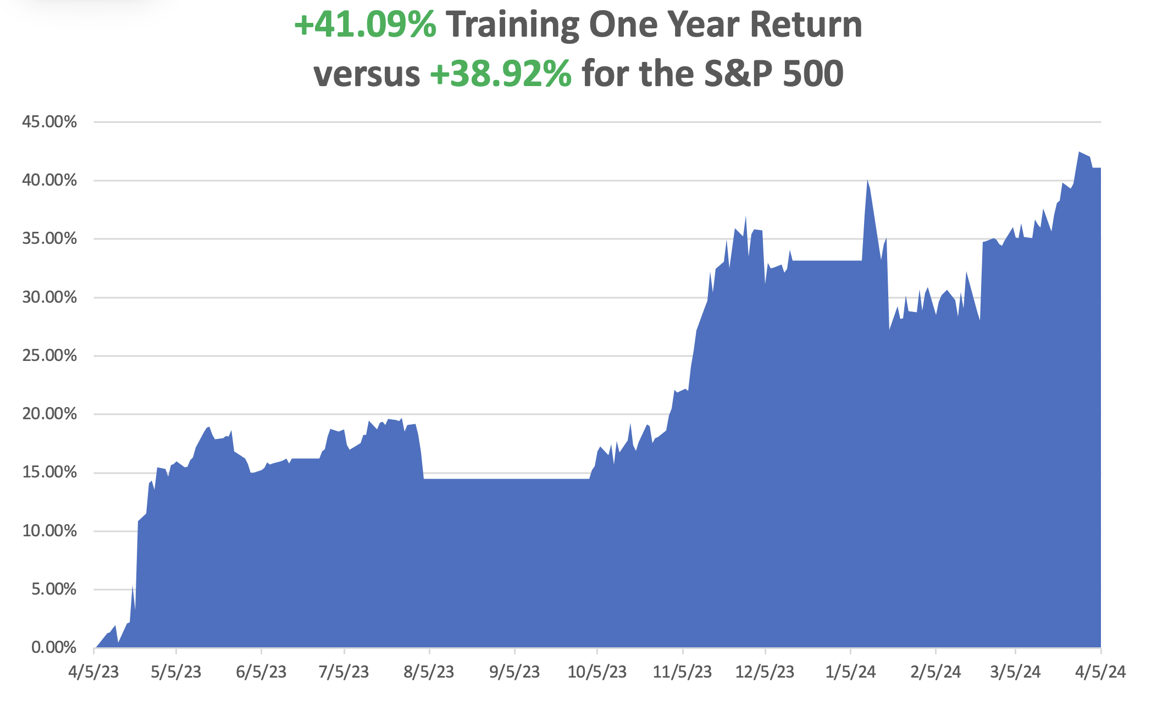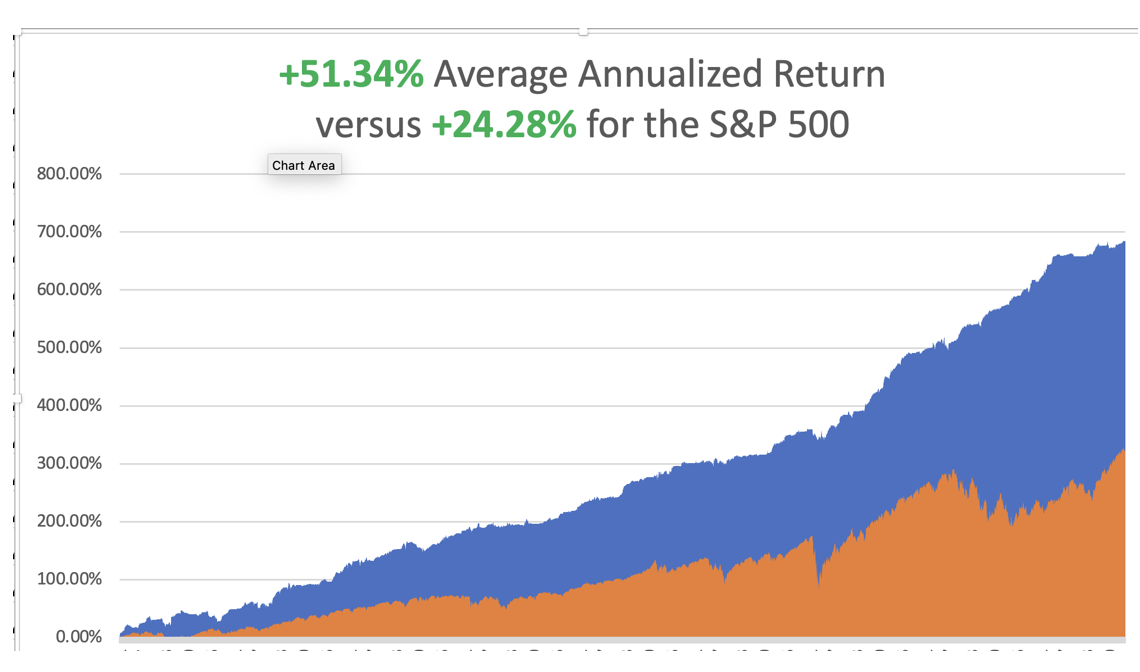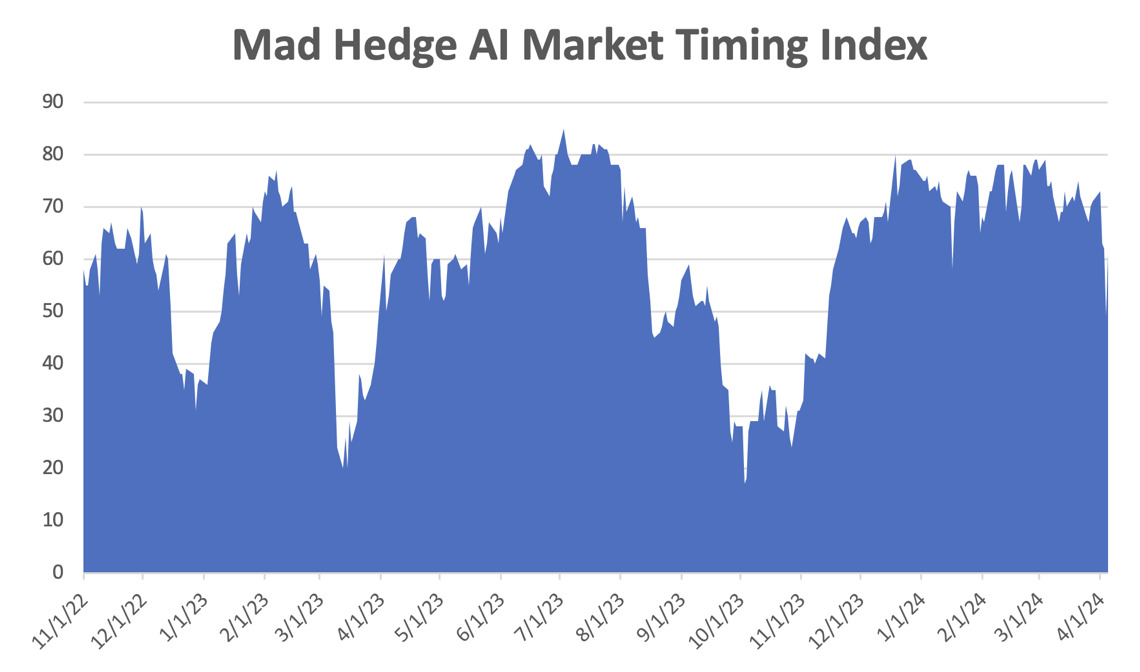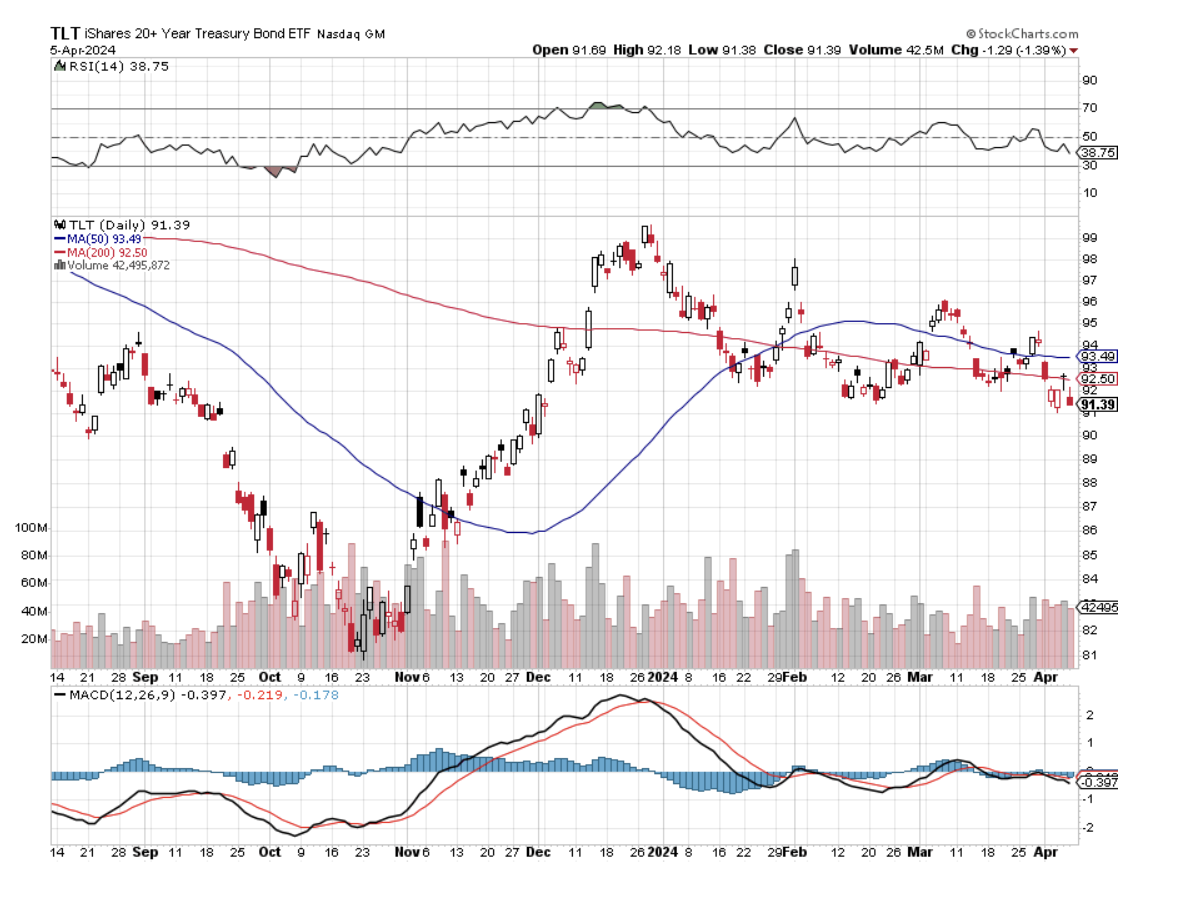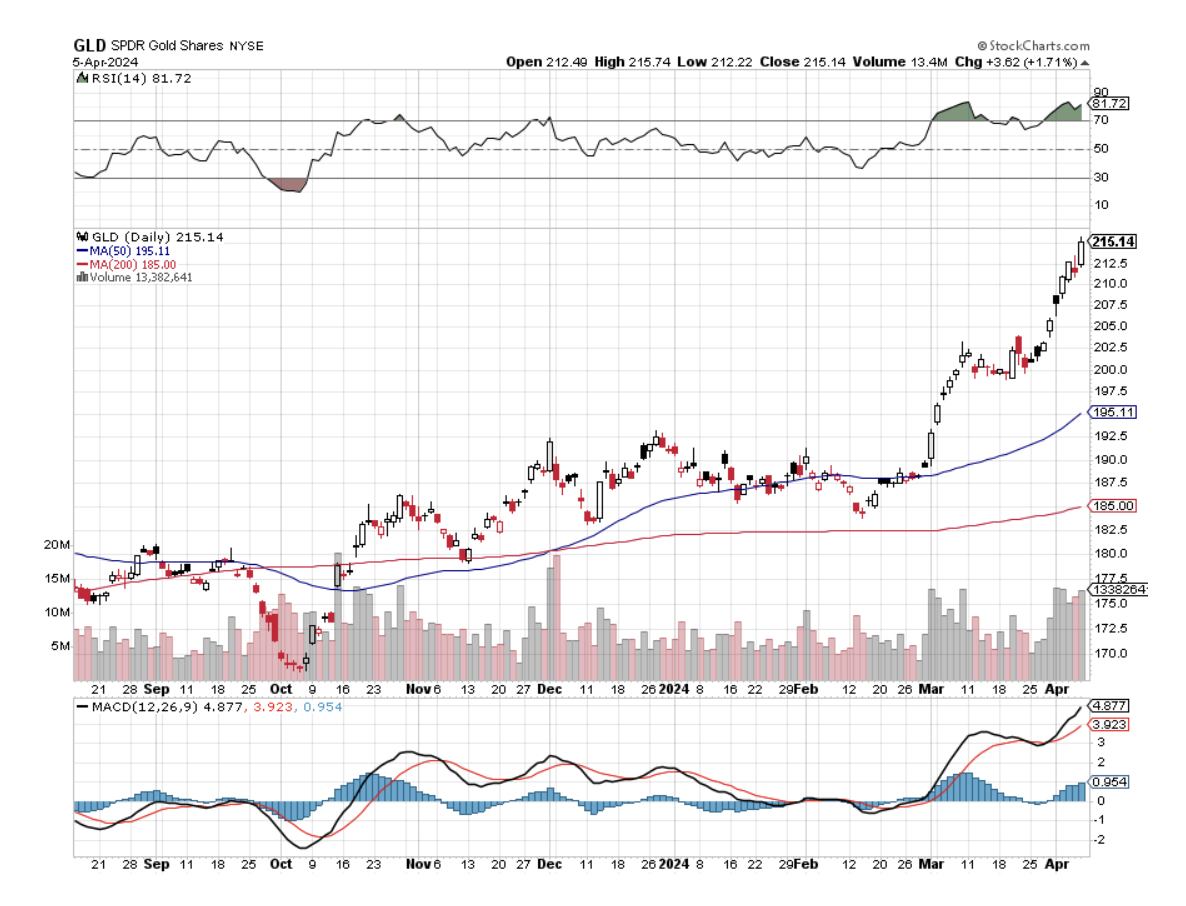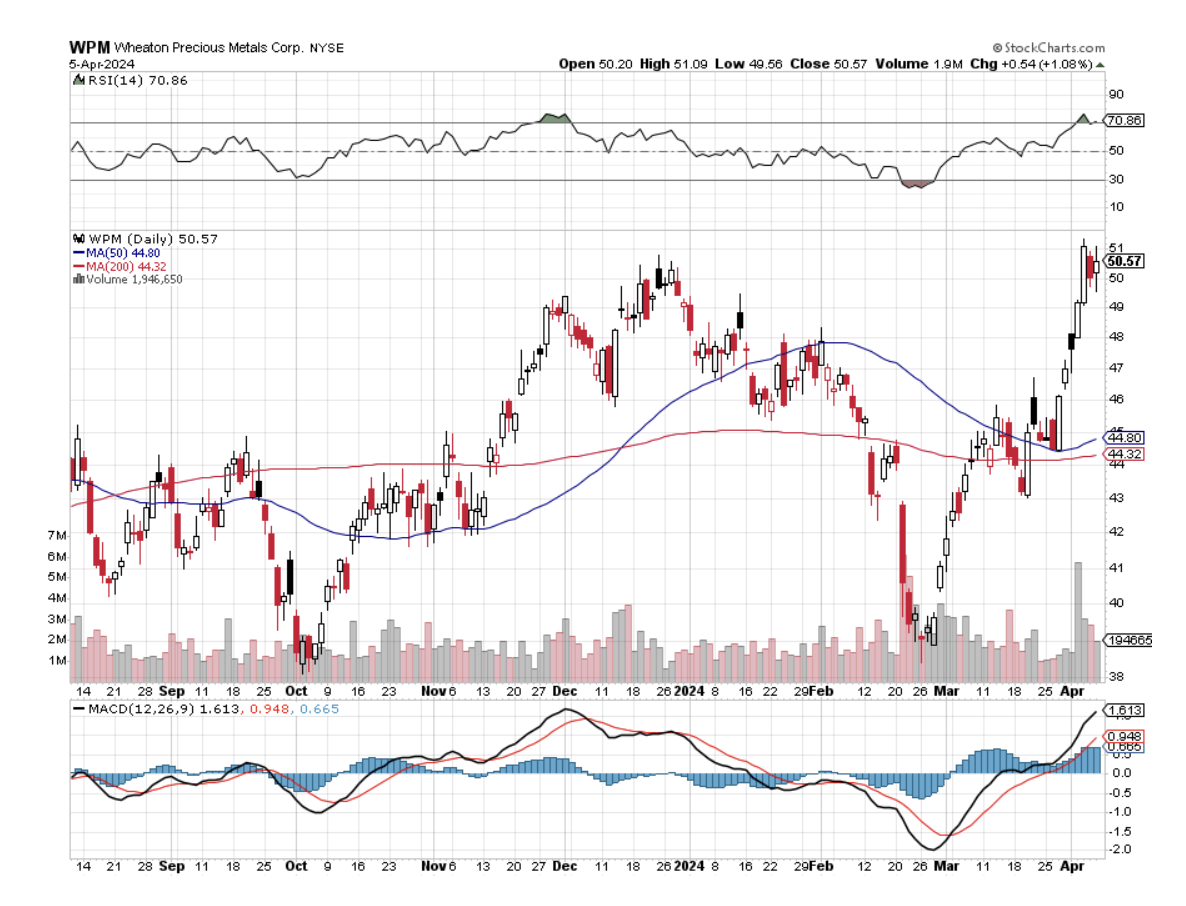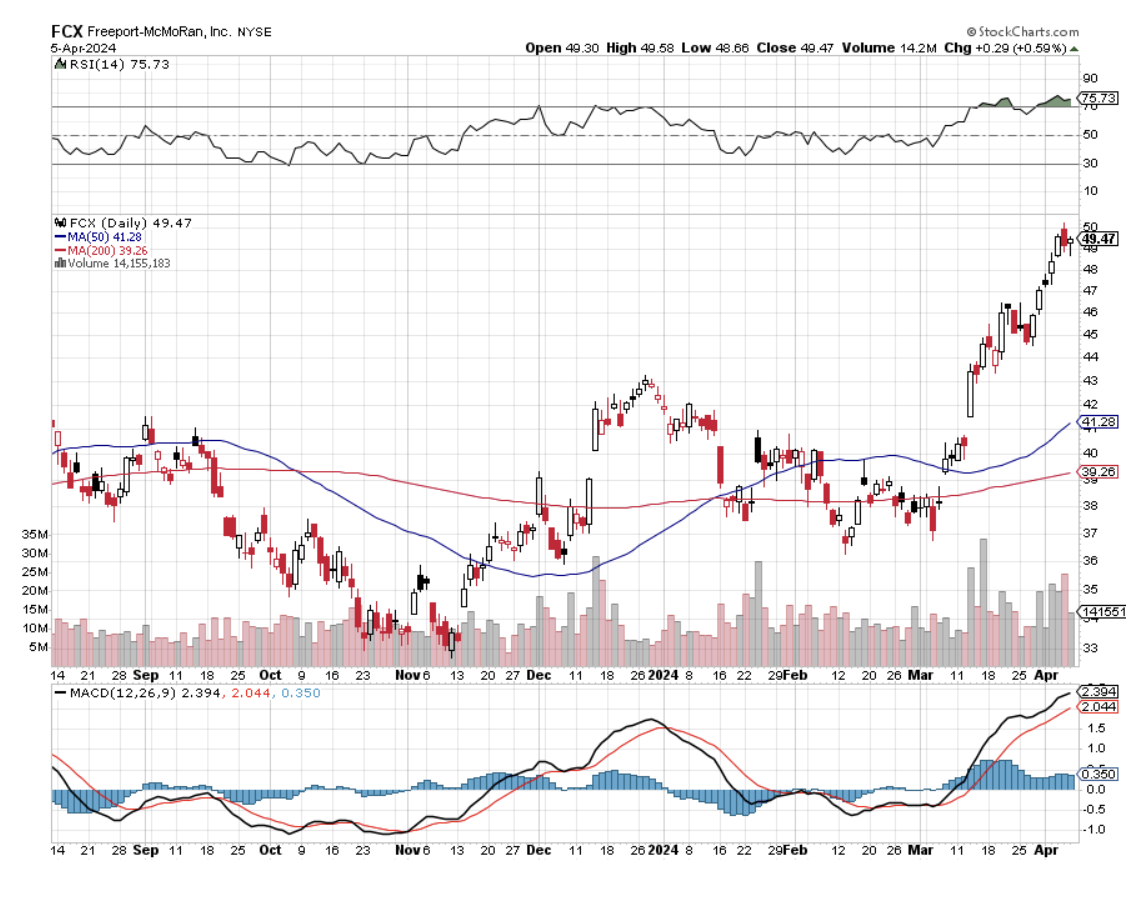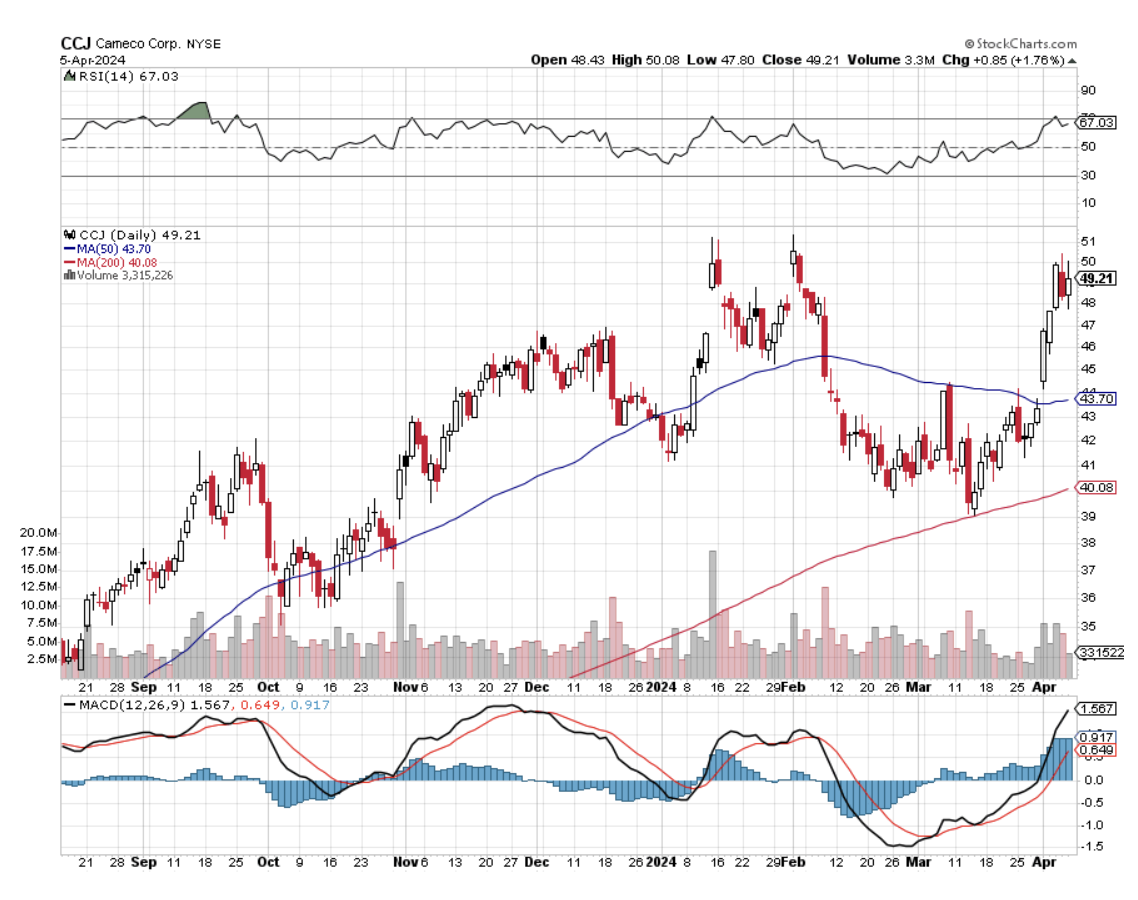
Global Market Comments
April 12, 2024
Fiat Lux
Featured Trade:
(JULY 2 VANCOUVER CANADA STRATEGY LUNCHEON),
(HOW TO HANDLE THE FRIDAY, APRIL 17 OPTIONS EXPIRATION),
(AND MY PREDICTION IS….),
(TESTIMONIAL)
Followers of the Mad Hedge Fund Trader alert service have the good fortune to own six in-the-money options positions that expire on Friday, April 19, and I just want to explain to the newbies how to best maximize their profits.
This involves the:
(FCX) 4/$37-$40 call spread
(XOM) 4/$100-$105 call spread
(OXY) 4/$59-$62 call spread
(WPM) 4/$39-$42 call spread
(TSLA) 4$140-$150 call spread
(GLD) 4/$194-$197 call spread
Provided that we don’t have a monster move down in the market in five trading days, these positions should expire at their maximum profit points.
So far, so good.
I’ll take the example of the (FCX) 4/$37-$40 call spread.
Your profit can be calculated as follows:
Profit: $3.00 expiration value - $2.60 cost = $0.40 net profit
(40 contracts X 100 contracts per option X $0.40 profit per option)
= $1,600 or 16.00% in 20 trading days.
Many of you have already emailed me asking what to do with these winning positions.
The answer is very simple. You take your left hand, grab your right wrist, pull it behind your neck, and pat yourself on the back for a job well done.
You don’t have to do anything.
Your broker (are they still called that?) will automatically use your long position to cover your short position, canceling out the total holdings.
The entire profit will be credited to your account on Monday morning, April 22 and the margin freed up.
Some firms charge you a modest $10 or $15 fee for performing this service.
If you don’t see the cash show up in your account on Monday, get on the blower immediately and find it.
Although the expiration process is now supposed to be fully automated, occasionally machines do make mistakes. Better to sort out any confusion before losses ensue.
If you want to wimp out and close the position before the expiration, it may be expensive to do so. You can probably unload them pennies below their maximum expiration value.
Keep in mind that the liquidity in the options market understandably disappears, and the spreads substantially widen, when a security has only hours, or minutes until expiration on Friday. So, if you plan to exit, do so well before the final expiration at the Friday market close.
This is known in the trade as the “expiration risk.”
One way or the other, I’m sure you’ll do OK, as long as I am looking over your shoulder, as I will be, always. Think of me as your trading guardian angel.
I am going to hang back and wait for good entry points before jumping back in. It’s all about keeping that “Buy low, sell high” thing going.
I’m looking to cherry-pick my new positions going into the next quarter end.
Take your winnings and go out and buy yourself a well-earned dinner. Just make sure it’s take-out. I want you to stick around.
Well done, and on to the next trade.
You Can’t Do Enough Research
Global Market Comments
April 11, 2024
Fiat Lux
Featured Trade:
(JOIN ME ON CUNARDS QUEEN ELIZABETH FOR MY JUNE 29 ALASKA SEMINAR AT SEA LUNCHEON)
(RIGHT SIZING YOUR TRADING)
“Savers are losers”, said a radio ad for a mortgage broker in Reno, Nevada.
Global Market Comments
April 10, 2024
Fiat Lux
Featured Trade:
(MAY 8 GALAPAGOS ISLANDS STRATEGY LUNCHEON)
(WHY THE UNDERGROUND ECONOMY IS GROWING SO FAST)
“2024 will be the fourth year of living dangerously,” said Ed Yardeni of Yardeni Research.
Global Market Comments
April 9, 2024
Fiat Lux
Featured Trade:
(APRIL 23 HAVANA CUBA STRATEGY LUNCHEON)
(My Favorite Passive/Aggressive Portfolio)
(ROM), (UYG), (UCC), (DIG), (BIB)
What if you want to be a little more aggressive with your investment strategy, say twice as aggressive? What if markets don’t deliver any year-on-year change from here?
Then you need a little more pizzazz in your portfolio, and some extra leverage to earn your crust of bread and secure your retirement.
It turns out that I have just the solution for you. This would be my “Passive/Aggressive Portfolio”.
I call it passive in that you just purchase these positions and leave them alone and do not trade them. I call it aggressive as it involves a basket of 2x leveraged ETFs issued by ProShares, based in Bethesda, MD (click here for their link).
The volatility of this portfolio will be higher. But the returns will be double what you would get with an index fund, and possibly much more. It is a “Do not open until 2035” kind of investment strategy.
Here is the makeup of the portfolio:
(ROM) –- ProShares Ultra Technology Fund - The three largest single stock holdings are Apple (AAPL), Microsoft (MSFT), and Facebook (FB). It is up 13.7% so far this year. For more details on the fund, please click here.
(UYG) – ProShares Ultra Financials Fund - The three largest single stock holdings are Wells Fargo (WFC), Berkshire Hathaway (BRK.B), and JP Morgan Chase (JPM). It is up 6.2% so far this year. For more details on the fund, please click here.
(UCC) – ProShares Ultra Consumer Services Fund - The three largest single stock holdings are Amazon (AMZN), (Walt Disney), (DIS), and Home Depot (HD). It is up 18.3% so far this year. For more details on the fund, please click here.
(DIG) -- ProShares Ultra Oil & Gas Fund - The three largest single stock holdings are ExxonMobile (XOM), Chevron (CVX), and Schlumberger (SLB). It is DOWN 38.2% so far this year. For more details on the fund, please click here.
(BIB) – ProShares Ultra NASDAQ Biotechnology Fund – The three largest single stock holdings are Amgen (AMGN), Regeneron (REGN), and Gilead Sciences (GILD). It is up 15% so far this year, but at one point (before the “Sell in May and Go away” I widely advertised) it was up a positively stratospheric 64%. For more details on the fund, please click here.
You can play around with the sector mix at your own discretion. Just focus on the fastest-growing sectors of the US economy, which the Mad Hedge Fund Trader does on a daily basis.
It is tempting to add more leveraged ETFs for sectors like gold (UGL), to act as an additional hedge.
There is also the 2X short Treasury bond fund (TBT), which I have been trading in and out of for years, a bet that long-term bonds will go down, and interest rates rise.
There are a couple of provisos to mention here.
This is NOT a portfolio you want to own going into a recession. So, you will need to exercise some kind of market timing, however occasional.
The good news is that I make more money in bear markets than I do in bull markets because the volatility is so high. However, to benefit from this skill set, you have to keep reading the Diary of a Mad Hedge Fund Trader.
There is also a problem with leveraged ETFs in that management and other fees can be high, dealing spreads wide, and tracking errors huge.
This is why I am limiting the portfolio to 2X ETFs, and avoiding their much more costly and inefficient 3X cousins, which are really only good for intraday trading. The 3X ETFs are really just a broker enrichment vehicle.
There are also going to be certain days when you might want to just go out and watch a long movie, like Gone With the Wind, with an all-ETF portfolio, rather than monitor their performance, no matter how temporary it may be.
A good example was the May 6 2010 flash crash, when the complete absence of liquidity drove all of these funds to huge discounts to their asset values.
Check out the long-term charts, and you can see the damage that was wrought by high-frequency traders on that cataclysmic day, down -53% in the case of the (ROM). Notice that all of these discounts disappeared within hours. It was really just a function of the pricing mechanism being broken.
I have found the portfolio above quite useful when close friends and family members ask me for stock tips for their retirement funds.
It was perfect for my daughter, who won’t be tapping her teacher’s pension accounts for another 30 years when I will be long gone. She mentions her blockbuster returns every time I see her, and she has only been in them for 10 years.
Imagine what technology, financial services, consumer discretionaries, biotechnology, and oil and gas will be worth then? It boggles the mind. My guess is up 100-fold from today’s levels.
You won’t want to put all of your money into a single portfolio like this. But it might be worth carving out 10% of your capital and just leaving it there.
That will certainly be a recommendation for financial advisors besieged with clients complaining about paying high fees.
Adding some spice, and a little leverage to their portfolios might be just the ticket for them.
The Istanbul Spice Market
It’s Time to Spice Up Your Portfolio
Global Market Comments
April 8, 2024
Fiat Lux
Featured Trade:
(MARKET OUTLOOK FOR THE WEEK AHEAD, or THE WINDFALL YEAR),
(FCX), (TLT), (TSLA), (NVDA), (FCX),
(XOM), (WPM), (GLD), (CCJ), (META), (AMZN),
(AN EVENING WITH TRAVEL GURU ARTHUR FROMMER)
This year seems to be the year of the windfall.
In January, we loaded up on Big Tech (AMZN), (MSFT), which then went ballistic.
In February, we doubled up on NVIDIA (NVDA), which then nearly doubled.
In March, spotting the shift into commodities, energy, and precious metals we loaded the boat with gold Freeport McMoRan (FCX), gold (GLD), silver (WPH), and oil (XOM), (OXY), which launched into torrid two-week straight up moves which continue. And for good measure, we dove into NVIDIA one more time.
Even the trades I thought about and talked about but never executed took off like a scalded chimp, such as uranium producer Cameco (CCJ), up 30% in weeks.
And while you’d think that trades like this would generate the performance of a lifetime, in fact, I begrudgingly admit I'm lagging behind the index this year. It’s incredibly annoying when after working 12 hours a day seven days a week, the indexers, the investors who sit on their hands all day and do nothing, are making more money than I am.
That’s because I put out a handful of ill-timed short positions in the S&P 500 (SPY) and Freeport McMoRan (FCX) which cut my numbers by half.
You may ask why I suffered the madness of putting out shorts when we are in a bull market and that everything is going straight up every day! That’s because I am the Mad Hedge Fund Trader, not the Mad Long-Term Investor. And hedge funds are always supposed to have balanced longs and shorts. I can tilt this by keeping only one short position against a basket of longs. But even those single longs have proved painfully expensive.
The issue here is that the market is not breathing as it normally does. There is no ebb and flow to let you in and out of positions. Sectors flatline, then launch into bull moves that take them up almost every day for months. That is an impossible market to trade.
I have only seen this twice during my lifetime: during the Great Japanese Stock Bubble of the 1980s and the Dotcom Bubble of the 1990s, which means we are in another one of these great bubbles, which will probably be the last of my lifetime.
The previous two great bubbles went on for five years. Greed can last a long time. If you count the October 26, 2023 low as the start of the new bull market, we have 4 ½ years to run in this one. What is more likely is that the pandemic low in April of 2020 was the start of this new bull market and we have averaged a 25% a year return in stocks since then. That means we have at least another year to run…. or more.
Valuations are at the high end of their recent range at 21 times S&P 500 earnings. But during the 1990’s bubble, the market average reached an earnings multiple in the 30s, and technology stocks reached a stratospheric 100 times earnings.
And today, earnings are still rising, sometimes quite sharply, such as the case with (NVDA) and (META). It’s when earnings are falling but stocks are still rising that you have to worry, as happened in 1999 and the first four months of 2000. In the 1980s in Tokyo, nobody ever looked at earnings.
Another frustration with trading today is the collapse of market volatility from $22 to $12 over the past year. That means we are getting paid half of what we were a year ago for the same options trade. You can make up for this loss of volatility by getting more aggressive with strike prices or maturities, but then that increases the number of stop losses.
And that’s the way it is.
You trade the market you have, not the one you want. But what do I know? I’ve only been doing this for 55 years.
I just thought you’d like to know.
NVIDIA Quarterly Earnings
So far in March, we are down -1.44%. My 2024 year-to-date performance is at +6.67%. The S&P 500 (SPY) is up +7.93% so far in 2024. My trailing one-year return reached +41.09% versus +38.92% for the S&P 500.
That brings my 16-year total return to +684.56%. My average annualized return has recovered to +51.57%.
Some 63 of my 70 round trips were profitable in 2023. Some 13 of 19 trades have been profitable so far in 2024.
I stopped out of my short position in Freeport McMoRan (FCX) last week. Markets that go straight up are hard to trade. I also came off my long in (TLT) close to cost. I initiated new longs in Tesla (TSLA) and NVIDIA (NVDA). I let my existing longs run in Freeport McMoRan (FCX), Occidental Petroleum, ExxonMobile (XOM), Wheaton Precious Metals (WPM), and Gold (GLD).
I am 70% invested and 30% in cash given the massive upside breakout in commodity, precious metals, and energy we have witnessed.
Nonfarm Payroll Jumps by 303,000 in March, almost double what was expected. The headline unemployment rate drops 0.1% to 3.8%. Wages rose 0.3% for the month and 4.1% from a year ago, both in line with Wall Street estimates. Health care led with 72,000 new jobs, followed by government (71,000), leisure and hospitality (49,000), and construction (39,000). Interest rate cuts fade into the future.
Weekly Jobless Claims Jump to 221,000, up 9,000, a two-month high. The weekly claims report from the Labor Department on Thursday also showed fewer people remaining on jobless rolls towards the end of March, suggesting that laid-off workers continued to find work, though not as easily as two years ago. There were 1.36 job openings for every unemployed person in February compared to 1.43 in January. Worker shortages persist in industries like construction.
Investors are Piling into Cash, with Money-Market funds getting $82 billion in the week through Wednesday. Investors are still flocking to cash funds, and history suggests redemptions won’t begin until a year after the Federal Reserve starts cutting interest. 5.35% for 90-day US Treasury Bond yields are still a huge draw for the cautious.
Commodities Trading Firms Harvest Record Profits, some $104 billion in 2023. The surprise increase from 2022, when the fallout from the war in Ukraine pushed up prices and supercharged profits, was driven by a wave of new entrants into the sector — including tech-focused traders and hedge funds — and rising returns from power trading activities. The figures reflect profits from the entire sector, including independent traders, banks, hedge funds, and national oil companies. This year will be even better.
Oil Continues to Bubble of Tight Supplies, supported by geopolitical tensions in the Middle East, concerns over tightening supply, and expectations about demand growth as economies improve. I’m keeping my longs in (XOM) and (OXY) and looking to pick up (COP) and (FANG).
US Dollar to Stay Higher for Longer, as a result of the higher for longer Fed tilt on interest rates. High-yielding currencies are always the strongest. The buck is up 3.3% this year against a currency basket.
Toyota Sales Soar by 20% in Q1, closely followed by Honda at 17.3%. General Motors delivered a pitiful 1.5% decline. Hybrids are the name of the day, outselling EVs and ICE cars. Toyota played it safe and won, at least for now.
Disney Wins Proxy Fight with Nelson Peltz, retaining complete control of the board. It’s a defeat for Peltz and a stamp of approval for the company’s board and CEO Bob Iger’s efforts to turn around the company. Nelson can now sell his shares for a big profit, up 30%.
PCE Comes in Hot at 0.3% for February, and 2.8% YOY, taking bonds. Personal Consumption Expenditures give an early read on inflation trends that the Fed loves. The economy is clearly much hotter than traders understand. Consumer spending shot up 0.8% on the month, well ahead of the 0.5% estimate. Personal income increased 0.3%, slightly softer than the 0.4% estimate.
Tesla Sales are Disastrous as expected, coming in at only 386,810, down 8.5% YOY. Shares drop as much as 6.7%, extending the biggest rout in the S&P 500. Analysts slashed projections in recent days, but not by enough. The Berlin factory was shut down and competition in China is ramping up. Still, Tesla produced 46,561 more cars than it sold in the quarter. For what it’s worth, BYD sales in China were even worse. The bottom for (TSLA) is fast approaching.
My Ten-Year View
When we come out the other side of the recession, we will be perfectly poised to launch into my new American Golden Age or the next Roaring Twenties. The economy decarbonizing and technology hyper accelerating, creating enormous investment opportunities. The Dow Average will rise by 800% to 240,000 or more in the coming decade. The new America will be far more efficient and profitable than the old.
Dow 240,000 here we come!
On Monday, April 8, at 7:00 AM EST, the US Consumer Inflations Expectations are announced.
On Tuesday, April 9 at 8:30 AM, the NFIB Business Optimism Index will be released.
On Wednesday, April 10 at 11:00 AM, the Core Inflation Rate for March is published
On Thursday, April 11 at 8:30 AM, the Weekly Jobless Claims are announced. The final read of the Q2 US GDP is also out.
On Friday, April 12 at 8:30 AM, the Producer Price Index is out. At 2:00 PM, the Baker Hughes Rig Count is printed.
As for me, since many of you are now planning long overdue summer vacations, I thought I would pass on what I learned from the ultimate travel guru of all time.
After all, who knows how long it will be until the next pandemic? The next decade, next year, or next week?
When I backpacked around Europe in 1968, I relied heavily on Arthur Frommer’s legendary paperback guide, Europe on $5 a Day, which then boasted a cult-like following among impoverished, but adventurous Americans. The charter airline business was then booming, plunging airfares, and suddenly Europe came within reach of ordinary Americans like me.
Over the following years, he directed me down cobblestoned alleyways, dubious foreign neighborhoods, and sometimes converted WWII air raid shelters, to find those incredible travel deals. When he passed through town some 50 years later, I jumped at the chance to chat with the ever-cheerful worshipped travel guru.
Frommer believes there are three sea change trends going on in the travel industry today. Business is moving away from the big three travel websites, Travelocity, Orbitz, and Priceline, who have more preferential lucrative but self-enriching side deals with airlines than can be counted, towards pure aggregator sites that almost always offer cheaper fares, like Kayak.com, Sidestep.com, and Fairchase.com.
There is a move away from traditional 48-person escorted bus tours towards small group adventures, like those offered by Gap Adventures, Intrepid Tours, and Adventure Center, that take parties of 12 or less on culturally eye-opening public transportation.
There has also been a huge surge in programs offered by universities that turn travelers into students for a week to study the liberal arts at Oxford, Cambridge, and UC Berkeley. His favorite was the Great Books program offered by St. John’s University in Santa Fe, New Mexico.
Frommer says that the Internet has given a huge boost to international travel, but warns against user-generated content, 70% of which is bogus, posted by the hotels and restaurants touting themselves.
The 94-year-old Frommer turned an army posting in Berlin in 1952 into a travel empire that publishes 340 books a year, or one out of every four travel books on the market. I met him on a swing through the San Francisco Bay Area (his ticket from New York was only $150), and he graciously signed my tattered, dog-eared original 1968 copy of his opus, which I still have.
Which country has changed the most in his 60 years of travel writing? France, where the citizenry has become noticeably more civil since losing WWII. Bali is the only place where you can still actually travel for $5/day, although you can see Honduras for $10/day. Always looking for a deal, Arthur’s next trip is to Chile, the only country in the world he has never visited.
With the advent of AI, Arthur has been met with an onslaught of new competition. Recently, Amazon (AMZN) has been flooded with hundreds of new travel books written entirely by algorithms. They have no human author who’s ever visited the country in question and are written entirely from existing information found on the Internet. But they’re cheap.
You can easily spot them from their wishy-washy non-committal language and factual errors and omissions. For example, I recently found a travel book about Ukraine that neglected to mention that there was a war going on there and that its cities were being bombed by Russians daily.
Not for me.
Good Luck and Good Trading,
John Thomas
CEO & Publisher
The Diary of a Mad Hedge Fund Trader
Arthur’s Next Big Play is Bali
1968 on the French Riviera

